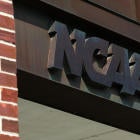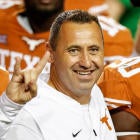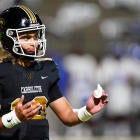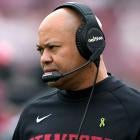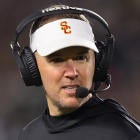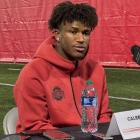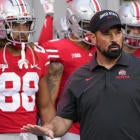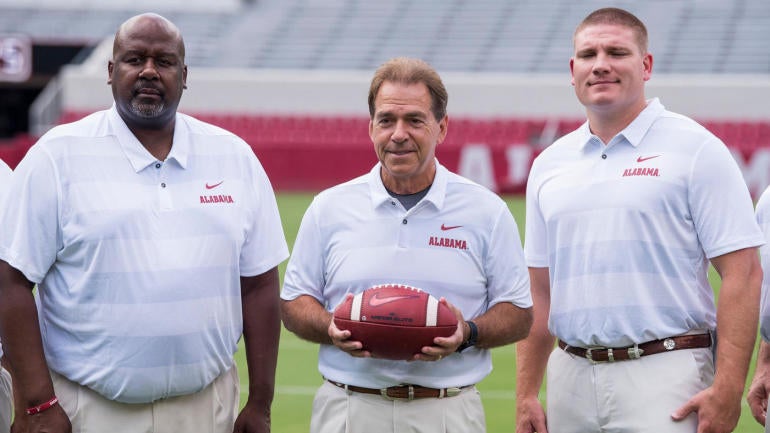
When Mike Locksley arrived in Tuscaloosa, Alabama, he had already been a head coach (New Mexico), offensive coordinator (Illinois, Maryland) and position coach at multiple schools.
Despite his long list of accomplishments, there was no grand welcome or red-carpet arrival when he joined Nick Saban's analyst army. Instead, Locksley received some Nike school gear, a seat at a folding table in a windowless room and a mandate to get to work as another cog in the machine.
"People are like, who is this guy?" said Locksley, now the coach at Maryland. "You're there for three or four months before anybody even knows you."
Saban had discovered a market advantage that revolutionized the sport. He could take experienced coaches who may have failed elsewhere and bring them into his Alabama program as off-field analysts.
Locksley teamed with Steve Sarkisian, fresh off a failed stint as USC's coach, to help offensive coordinator Lane Kiffin with third-down and red zone strategy. The duo made a combined $80,000.
"He'd take it, put it on the call sheet and go ahead and call a helluva game," Locksley said. "I'm saying to myself this is genius because you've got two dudes that have called plays, game plan and it gives Lane a tremendous starting point."
Grabbing coaches like Locksley, Sarkisian and Billy Napier on the cheap for the behind-the-scenes roles helped spark an unbelievable run of success for Saban. But with looming athlete revenue sharing certain to eat into athletic department budgets across the country, could the days of the analyst armies be numbered?
New Alabama coach Kalen DeBoer's on-field staff is actually slightly more expensive than Saban's from 2023, but the program has slimmed down its off-field analyst workforce from 12 to eight. That number is slightly skewed because of the creation of a general manager role (Courtney Morgan) and increasing the number of special assistants from two to three, which included the hiring of two sitting FBS head strength and conditioning coaches (Ron McKeefery and Matt Shadeed).
Gone are prominent head-coach-turned-analysts like Charlie Strong (formerly at Texas) and Derek Dooley (formerly at Tennessee). Ex-Rutgers offensive coordinator John McNulty and former Tide linebacker Jamey Mosley are the lone analyst holdovers from Saban's last staff.
That's not a coincidence. Power Four schools are responsible for a new $22 million annual expense as part of the House v. NCAA settlement terms. Alabama has quietly worked to stay ahead of the budget curve and avoid drastic decisions like cutting sports.
Alabama spent more than $1 million on analysts alone in 2023, according to public records. Alabama also listed 69 off-field staffers in its 2023 media guide, including five in recruiting, four in player personnel, three in player development, two special assistants (former Arizona Cardinals coach Ken Whisenhunt was one) and two chefs.
"We're always looking for opportunities to be more efficient in what we do but also make sure that we do it at a level that we expect," Alabama athletic director Greg Byrne told CBS Sports. "We're in a new world, and we have to adjust to that."
Bigger isn't always better
When Florida hired Billy Napier in December 2021, it gave him a $5 million salary pool for off-field analysts and other personnel.
"We're going to hire an army of people here," Napier said after he was hired. "We're going to create an infrastructure not only in the personnel department but also from an on-campus recruiting, creative media, name, image and likeness. We've got a great vision for the organization that we're going to create here."
Napier took what he learned from Alabama and Clemson and added 21 non-coaching positions, including a "GameChanger Coordinator," a director of player engagement and NIL and multiple full-time dietitians.
But after only 11 total wins in two years, Napier's army hasn't led to a marked improvement on the field. Moving forward, those off-field position requests will come with greater scrutiny.
College football has long been viewed as the sacred cow within athletic departments as schools pour money into their programs in the hopes of a national championship. The House settlement won't end that, but it could prompt a spending slowdown in some areas.
"Are we going to grow revenue?" said Florida athletic director Scott Stricklin. "If you look at it just from a revenue place: By having another coach, another analyst, does it grow our revenue number? I don't think it does."
Not everyone is slowing down, though. After benefitting from the help of Sarkisian and Locksley during his time at Alabama, Ole Miss' Lane Kiffin has taken the analyst baton from Saban this offseason. The Rebels added former New York Giants coach Joe Judge and former Mississippi State coach Zach Arnett as analysts to a group that already included former UCLA defensive coordinator Lou Spanos.
Future of the analyst position
While shrinking budgets threaten to reduce the number of analyst jobs, there is pending legislation that could change the very nature of the position. The FBS Oversight Committee passed a proposal last month that would eliminate the current cap of 10 on-field assistant coaches and allow analysts, graduate assistants and quality control staffers to directly coach players. The Division I Council is expected to make a decision at the end of the month after rejecting the same proposal a year ago.
Concerns over rising costs and competitive imbalance were the reason for the rule's rejection last year, according to The Athletic. Those worries have only been amplified over the past 12 months with several Power Four schools poaching Group of Five on-field assistants for analyst roles.
Whether the new rule passes or not, expect athletic directors across the country to look at staff hires with increasing scrutiny in the future.
"As much as people think there's unlimited money, there's not," Byrne said. "You have to make financial decisions."













